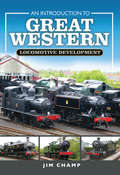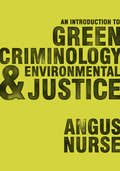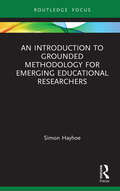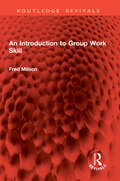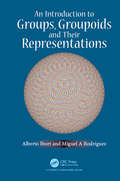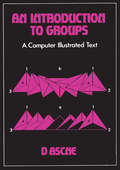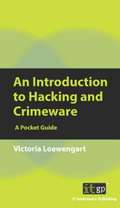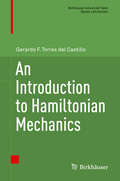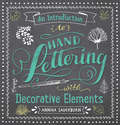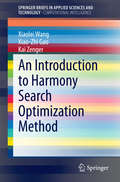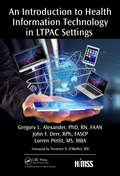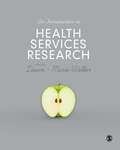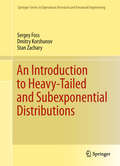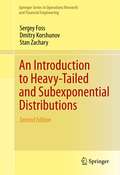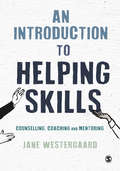- Table View
- List View
An Introduction to Gravity Currents and Intrusions
by Marius UngarishGravity currents and intrusions are the ubiquitous phenomena where a fluid of one density flows horizontally into a fluid of a different density. For researchers and engineers, the ability to understand and predict these flow fields is essential in wide-ranging applications including those involved with atmospheric and ocean dynamics, the propagati
An Introduction to Great Western Locomotive Development
by Jim ChampThe first thought, when contemplating a new study of the Great Western Railway locomotive fleet, must surely be to ask what can there be left to say? But there is no single source which gives a general introduction to the Great Western locomotive fleet. There are monographs on individual classes, an excellent multi-volume detail study from the RCTS, and superb collections of photographs, but nothing that brings it all together. This work is intended to provide that general introduction.The volume begins with a series of short essays covering general trends in design development, whilst the main body of the volume covers individual classes. For each class there is a small table containing some principal dimensions and paragraphs of text, covering an introduction, renumbering, key changes in the development of the class and information on withdrawal.The volume concludes with appendices covering the development and types of standard boilers, the various numbering schemes used by the GWR, the arcane subject of locomotive diagrams and lot numbers, and a short reference on the many lines the GWR engulfed.The majority of illustrations are new profile drawings to a consistent format. Described as sketches, they are drawn to a consistent scale, but do not claim to be scale drawings. Much minor equipment has been omitted and the author has certainly not dared to include rivets! Although most are based around GWR weight diagrams, they are not simple traces of the original drawings. Detail has been added from other sources, components copied from different drawings and details have been checked against historical and modern photographs. One must also bear in mind that steam locomotives were not mass produced. Minor fittings frequently varied in position and changes were made over the locomotives' lifetimes. Nevertheless, this collection of drawings provides a uniquely consistent view of the GWR locomotive fleet.
An Introduction to Greek
by Henry Lamar Crosby John Nevin SchaefferGenerations of students have discovered the enduring pleasures of ancient Greek with this classic text. Supplemented by exercises, readings, and review lessons, it presents concise but thorough coverage of grammatical forms and syntax. Students advance from the simple fundamentals of the alphabet and declensions to the complexities of conditional sentences, and they acquire a Greek vocabulary of more than 600 basic words.Each chapter begins with a Greek motto, offering insights into classical attitudes and values. Reading selections include the works of Plato, Herodotus, and Homer as well as excerpts from ancient playwrights and the New Testament. More than 120 illustrations depict images of Greek culture related to archaeology, history, and literature. This comprehensive introduction also features Greek-to-English and English-to-Greek glossaries, a complete grammatical appendix, and supplemental information on word formation and etymology.
An Introduction to Greek Tragedy
by Ruth ScodelThis book provides a brief and accessible introduction to Greek tragedy for students and general readers alike. Whether readers are studying Greek culture, performing a Greek tragedy, or simply interested in reading a Greek play, this book will help them to understand and enjoy this challenging and rewarding genre. An Introduction to Greek Tragedy provides background information; helps readers appreciate, enjoy, and engage with the plays themselves; and gives them an idea of the important questions in current scholarship on tragedy. Ruth Scodel seeks to dispel misleading assumptions about tragedy, stressing how open the plays are to different interpretations and reactions. In addition to general background, the book also includes chapters on specific plays, both the most familiar titles and some lesser-known plays - Persians, Helen, and Orestes - in order to convey the variety that the tragedies offer readers.
An Introduction to Green Criminology and Environmental Justice
by Dr Angus NurseA comprehensive introduction to green criminology, this book is a discussion of the relationship between mainstream criminal justice and green crimes. Focused on environmental harm within the context of criminal justice this book takes a global perspective and Introduces students to different theoretical perspectives in green criminology Looks at the victims of environmental crime throughout Covers topics such as; wildlife crimes, animal abuse, the causes of environmental crime, regulation, exploitation, environmental activism, policing, prosecution and monitoring. Designed to help readers develop a thorough understanding of the principles of environmental justice and green criminology, as well as contemporary developments, this book will be excellent support to students of green criminology and environmental crime.
An Introduction to Green Criminology and Environmental Justice
by Dr Angus NurseA comprehensive introduction to green criminology, this book is a discussion of the relationship between mainstream criminal justice and green crimes. Focused on environmental harm within the context of criminal justice this book takes a global perspective and Introduces students to different theoretical perspectives in green criminology Looks at the victims of environmental crime throughout Covers topics such as; wildlife crimes, animal abuse, the causes of environmental crime, regulation, exploitation, environmental activism, policing, prosecution and monitoring. Designed to help readers develop a thorough understanding of the principles of environmental justice and green criminology, as well as contemporary developments, this book will be excellent support to students of green criminology and environmental crime.
An Introduction to Grounded Methodology for Emerging Educational Researchers (Qualitative and Visual Methodologies in Educational Research)
by Simon HayhoeIntroducing the reader to grounded methodology and its ethical approach, this book explores the theory behind the method as well as how to use it to develop and evaluate learning and education projects. Grounded methodology is designed to challenge traditional educational research methodologies, and in doing so questions the notion of the need for highly formal research in institutional settings. In this respect, it is also a simple way of planning an educational project that needs an evaluative element. Covering data collection techniques used in the course of education research such as observations, interviews, course development, participant diaries and online data collection, this book investigates the practical realities of researching in education contexts and the differences in educational, national and cultural backgrounds. It is ideal reading for students and academics looking to update and increase their knowledge on grounded methodology, especially students who are researchers in final-year undergraduate or post-graduate level programs, or instructors planning to teach grounded theory or grounded methodology to their own emerging research students.
An Introduction to Group Work Skill (Routledge Revivals)
by Fred MilsonFirst Published in 1973, An Introduction to Group Work Skill is designed to make the understanding of group work skills accessible to all- mothers, teachers, employers, as well as professional social workers. Dr Milson argues that this lengthy and imaginative excursion has been thought necessary as we are here concerned with the behaviour of people in groups which meet fairly regularly, which are small enough to provide opportunities for every member to know every other member as a person, and where there is a goal to be achieved which calls for a contribution from each.The author further argues that group work skill is composed of observation, interpretation, and action, and he proceeds to analyze each of these elements in successive chapters. This is an interesting read for students of sociology of work and social work.
An Introduction to Groups, Groupoids and Their Representations: An Introduction
by Alberto Ibort Miguel A. RodriguezThis book offers an introduction to the theory of groupoids and their representations encompassing the standard theory of groups. Using a categorical language, developed from simple examples, the theory of finite groupoids is shown to knit neatly with that of groups and their structure as well as that of their representations is described. The book comprises numerous examples and applications, including well-known games and puzzles, databases and physics applications. Key concepts have been presented using only basic notions so that it can be used both by students and researchers interested in the subject. Category theory is the natural language that is being used to develop the theory of groupoids. However, categorical presentations of mathematical subjects tend to become highly abstract very fast and out of reach of many potential users. To avoid this, foundations of the theory, starting with simple examples, have been developed and used to study the structure of finite groups and groupoids. The appropriate language and notions from category theory have been developed for students of mathematics and theoretical physics. The book presents the theory on the same level as the ordinary and elementary theories of finite groups and their representations, and provides a unified picture of the same. The structure of the algebra of finite groupoids is analysed, along with the classical theory of characters of their representations. Unnecessary complications in the formal presentation of the subject are avoided. The book offers an introduction to the language of category theory in the concrete setting of finite sets. It also shows how this perspective provides a common ground for various problems and applications, ranging from combinatorics, the topology of graphs, structure of databases and quantum physics.
An Introduction to Groups: A Computer Illustrated Text (A\computer Illustrated Text Ser.)
by D AscheAn Introduction to Groups: A Computer Illustrated Text discusses all the concepts necessary for a thorough understanding of group theory. The book covers various theorems, including Lagrange and Sylow. It also details Cayley tables, Burnside's lemma, homomorphisms, and dicyclic groups. The book is ideal for advanced mathematics students and beginning undergraduates.
An Introduction to HTML5 Game Development with Phaser.js
by Travis FaasExperience the thrill of crafting your own HTML5 game with Phaser.js game engine. HTML5 and modern JavaScript game engines have helped revolutionized web based games. Each chapter in An Introduction to HTML5 Game Development with Phaser.js showcases a sample game that illustrates an aspect of Phaser.js (now Lazer.js) that can be used as is, or in remixed games of the developer’s design. Each of these examples help the reader to understand how to optimize JavaScript game development with modern project tooling like Grunt and Bower. Though the world of HTML game development continues to grow and evolve, An Introduction to HTML5 Game Development with Phaser.js, provides a grounded resource and vital learning tool to anyone looking to optimize web game development process. Key Features Chapter objectives and examples with sample code make concepts easy to grasp Master questions and chapter summaries further help to solidify these concepts Feature boxes that contain important hints and things to note help keep readers on the right path This book uses a "building blocks" approach to game development and starts with the technology required to get things running Each chapter will be a small sample game that demonstrates one piece of Phaser.js, giving the reader time to grasp and understand the core concepts Subsequent chapters will demonstrate new features, building upon the knowledge of previous examples
An Introduction to Hacking and Crimeware
by Victoria LoewengartDefend your business, protect your livelihood, safeguard your future. Cybercrime is on the rise. Unchecked, it could destroy the entire global cyber infrastructure and wipe out many businesses. We need to defend ourselves against it, and we must fight back. Toolkits to create malware are now readily available to anyone wishing to defraud and do damage. For your business to survive and thrive, it is vital to stay informed about the threats and the risks, and arm yourself against them. Know your enemyAn Introduction to Hacking & Crimeware is a comprehensive guide to the most recent and the more serious threats. Knowing about these threats will help you understand how to ensure that your computer systems are protected and that your business is safe, enabling you to focus on your core activities. Fighting backIn this pocket guide, the author:defines exactly what crimeware is _ both intentional and unintentional _ and gives specific, up-to-date examples to help you identify the risks and protect your businessexplores the increasing use of COTS tools as hacking tools, exposing the enemy_s tactics gives practical suggestions as to how you can fight backprovides a valuable list of up-to-date, authoritative sources of information, so you can stay abreast of new developments and safeguard your business.
An Introduction to Hamiltonian Mechanics (Birkhäuser Advanced Texts Basler Lehrbücher)
by Gerardo F. Torres del CastilloThis textbook examines the Hamiltonian formulation in classical mechanics with the basic mathematical tools of multivariate calculus. It explores topics like variational symmetries, canonoid transformations, and geometrical optics that are usually omitted from an introductory classical mechanics course. For students with only a basic knowledge of mathematics and physics, this book makes those results accessible through worked-out examples and well-chosen exercises.For readers not familiar with Lagrange equations, the first chapters are devoted to the Lagrangian formalism and its applications. Later sections discuss canonical transformations, the Hamilton–Jacobi equation, and the Liouville Theorem on solutions of the Hamilton–Jacobi equation. Graduate and advanced undergraduate students in physics or mathematics who are interested in mechanics and applied math will benefit from this treatment of analytical mechanics. The text assumes the basics of classical mechanics, as well as linear algebra, differential calculus, elementary differential equations and analytic geometry. Designed for self-study, this book includes detailed examples and exercises with complete solutions, although it can also serve as a class text.
An Introduction to Hand Lettering with Decorative Elements (Lettering, Calligraphy, Typography)
by Annika SauerbornA treasure trove of lettering styles and decorative elements, this handy reference offers an abundance of eye-catching alphabets, numerals, ribbons, borders, flowers, banners, and other easy-to-trace embellishments. With this guide, it's easy to add a personal touch—humorous, dramatic, or romantic—to any handwritten message or meditative journal.Hundreds of ornaments, all of them hand-drawn by the author, include dozens of alphabets and numerals. You'll also find frames, flourishes, and corner designs that provide pages with a stylish finishing touch. Decorative motifs range from arrows, hearts, and stars to leaves, blossoms, and wreaths. A wealth of fanciful graphics for special occasions includes designs for birthdays, weddings, holidays, and all four seasons. Calligraphers, crafters, and illustrators as well as anyone who wants to add a bit of pizzazz to their writing will prize this imaginative source of inspiration.
An Introduction to Harmony Search Optimization Method (SpringerBriefs in Applied Sciences and Technology)
by Xiaolei Wang Xiao-Zhi Gao Kai ZengerThis brief provides a detailed introduction, discussion and bibliographic review of the nature1-inspired optimization algorithm called Harmony Search. It uses a large number of simulation results to demonstrate the advantages of Harmony Search and its variants and also their drawbacks. The authors show how weaknesses can be amended by hybridization with other optimization methods. The Harmony Search Method with Applications will be of value to researchers in computational intelligence in demonstrating the state of the art of research on an algorithm of current interest. It also helps researchers and practitioners of electrical and computer engineering more generally in acquainting themselves with this method of vector-based optimization.
An Introduction to Health Information Technology in LTPAC Settings (HIMSS Book Series)
by Gregory L. Alexander, PhD, RN, FAAN Derr F. John, RPh, FASCP Lorren Pettit, MS, MBAA multiplicity of factors converging together suggest the long term/post-acute care (LTPAC) provider community (e.g. nursing homes, behavioral health facilities, home health agencies, etc.) will accelerate in importance within the healthcare ecosystem during the next few years. The challenge for many LTPAC providers in this emerging environment will be to advance their clinical health information technologies (health IT) capabilities in order to "play" with other providers in the healthcare "sandbox." This book is designed to assist LTPAC leaders in identifying and exploring the array of critical issues one needs to consider in order to operate within an advanced clinical health IT ecosystem. This book surveys key issues surrounding the use of clinical health IT in LTPAC settings, to include providing readers with a suggested strategic plan and roadmap for selecting and installing digital health technologies in LTPAC organizations. Though the focus of the book primarily centers on the U.S. LTPAC provider’s experience, the authors also spend time addressing global and future LTPAC considerations.
An Introduction to Health Policy: A Primer for Physicians and Medical Students
by William H. Frist Manish K. SethiBased on the current climate of our nation's finances and healthcare spending, it is clear that young doctors and medical students are likely to see a dramatic transformation of the manner in which America offers medical care to its citizens over the course of their careers. As such, it is pivotal that the next generation of America's leaders on the front lines of medicine develop a sense of where healthcare has evolved from and future potential directions of change. An Introduction to Health Policy: A Primer for Physicians and Medical Students is the first of its kind: a book written by doctors for doctors in order to allow busy physicians and medical students to quickly develop an understanding of the key issues facing American healthcare. This book seeks to efficiently and effectively educate physicians and medical students in a clinical context that they can understand on the past, present, and potential future issues in healthcare policy and the evolution of American healthcare. The reader will walk away from the book with the ability to discuss the fundamental issues in American healthcare with ease.
An Introduction to Health Services Research: A Practical Guide
by Dawn-Marie WalkerThis is a primary, comprehensive textbook for people who are considering undertaking a piece of health-related research. It is an accessible companion with the aim of getting the reader to think broadly about all of the issues that need to be considered when embarking on a project. This is a pragmatic book, a step-by-step guide to research which mirrors the structure of a research project, taking you through the thought process for designing and conducting your study from formulating the right research question at idea inception, ascertaining what methodologies and analysis can answer what type of questions, right through to dissemination, all presented in an easy, digestible style. The book is full of case study illustrations and practical tips such as how to work out a research budget and obtaining funding for your project, discussion of what permissions need to obtained when conducting research with people, and how to involve public and patients. The authors are all experienced researchers and so this book is an accumulation of collective wisdom on common research challenges and issues.
An Introduction to Health and Safety Law: A Student Reference
by David BransonAn Introduction to Health and Safety Law provides a clear, concise overview of health and safety law in the United Kingdom. With reference to the European Union, this book discusses criminal and civil liability at length to provide a clear understanding of this area of law which has been subject to change over the 20 years. Key case studies and statistical information on prosecutions, fines and enforcement notices help to contextualise health and safety law to provide students and professionals with a full understanding of health and safety law in the UK. This book includes chapters on: the legal framework criminal liability enforcement of criminal liability civil liability civil remedy subordinate legislation. This book is an essential reference for students studying towards NEBOSH qualifications and students studying at university level. It provides a comprehensive understanding of UK health and safety law and will be a useful reference when entering the professional field.
An Introduction to Hearing (Psychology Revivals)
by David M. GreenOriginally published in 1976, this introduction to hearing was intended to provide a sufficient introduction to each of several subareas of hearing so that the serious student can read the more advanced treatments with greater appreciation and understanding. It was intended for upper graduate and graduate students. It assumes some mathematical sophistication – calculus for example, but there is some review of more basic concepts, such as logarithms. There is also a brief treatment of the necessary material from the different disciplines – physics, physiology, psychology, anatomy and mathematics – that a student of hearing will need to know.
An Introduction to Heavy-Tailed and Subexponential Distributions (Springer Series in Operations Research and Financial Engineering #38)
by Dmitry Korshunov Stan Zachary Sergey FossHeavy-tailed probability distributions are an important component in the modeling of many stochastic systems. They are frequently used to accurately model inputs and outputs of computer and data networks and service facilities such as call centers. They are an essential for describing risk processes in finance and also for insurance premia pricing, and such distributions occur naturally in models of epidemiological spread. The class includes distributions with power law tails such as the Pareto, as well as the lognormal and certain Weibull distributions.<P><P> This monograph defines the classes of long-tailed and subexponential distributions in one dimension and provides a complete and comprehensive description of their properties. New results are presented in a simple, coherent and systematic way. This leads to a comprehensive exposition of tail properties of sums of independent random variables whose distributions belong to the long-tailed and subexponential class.<P> The book includes a discussion of and references to contemporary areas of applications and also contains preliminary mathematical material which makes the book self contained. Modelers in the fields of finance, insurance, network science and environmental studies will find this book to be an essential reference.
An Introduction to Heavy-Tailed and Subexponential Distributions, 2nd Edition (Springer Series in Operations Research and Financial Engineering)
by Dmitry Korshunov Stan Zachary Sergey FossHeavy-tailed probability distributions are an important component in the modeling of many stochastic systems. They are frequently used to accurately model inputs and outputs of computer and data networks and service facilities such as call centers. They are an essential for describing risk processes in finance and also for insurance premia pricing, and such distributions occur naturally in models of epidemiological spread. The class includes distributions with power law tails such as the Pareto, as well as the lognormal and certain Weibull distributions.<P><P> One of the highlights of this new edition is that it includes problems at the end of each chapter. Chapter 5 is also updated to include interesting applications to queueing theory, risk, and branching processes. New results are presented in a simple, coherent and systematic way.<P> Graduate students as well as modelers in the fields of finance, insurance, network science and environmental studies will find this book to be an essential reference.
An Introduction to Helping Skills: Counselling, Coaching and Mentoring
by Jane WestergaardReaders will be introduced to the three core approaches of counselling, coaching and mentoring, and shown how they work across a variety of settings, including therapy, teaching, social work and nursing. Part 1 takes readers through the theory, approaches and skills needed for helping work, and includes chapters on: The differences and similarities of counselling, coaching and mentoring Foundational and advanced skills for effective helping Supervision and reflective practice Ethical helping and working with diversity Part 2 shows how helping skills look in practice, in a variety of different helping professions. 10 specially-written case studies show you the intricacies of different settings and client groups, including work in schools, hospitals, telephone helplines and probation programs.
An Introduction to Helping Skills: Counselling, Coaching and Mentoring
by Jane WestergaardReaders will be introduced to the three core approaches of counselling, coaching and mentoring, and shown how they work across a variety of settings, including therapy, teaching, social work and nursing. Part 1 takes readers through the theory, approaches and skills needed for helping work, and includes chapters on: The differences and similarities of counselling, coaching and mentoring Foundational and advanced skills for effective helping Supervision and reflective practice Ethical helping and working with diversity Part 2 shows how helping skills look in practice, in a variety of different helping professions. 10 specially-written case studies show you the intricacies of different settings and client groups, including work in schools, hospitals, telephone helplines and probation programs.
An Introduction to Heritage Breeds: Saving and Raising Rare-Breed Livestock and Poultry
by Alison Martin D. Phillip Sponenberg DVM Jeannette BerangerDeveloped for the particular needs of the working farm, heritage breeds have proved invaluable to small-scale agricultural production for centuries. This comprehensive guide explains why conserving heritage breeds remains important and how they often can be a better choice for the modern farmer than conventional animals. With profiles of heritage poultry, sheep, cattle, and more, you’ll learn how to select and successfully raise the breed that is right for your specific needs. Enjoy the benefits of resilient livestock while preserving genetic diversity for future generations.

